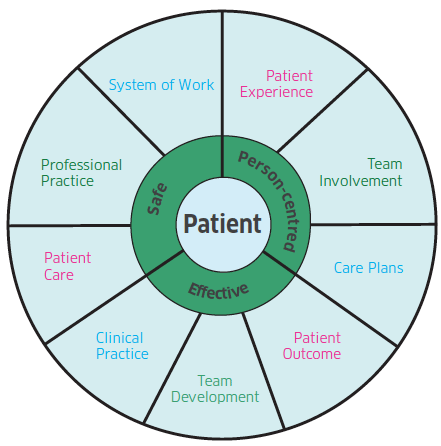Annual Report Of The Chief Dental Officer 2012
Inaugural Annual Report on the dental health of the Scottish population from the Chief Dental Officer, Margie Taylor.
7. Quality and Best Practice
7.1 Introduction
The vision for dentistry is for patients to have better oral health through evidence-based dental care provided in a safe clinical environment, and for the whole dental team to continually improve its professional practice, thereby ensuring effective patient care is delivered in well-maintained,
high-quality premises.
Best clinical practice is underpinned by robust, relevant, evidence-based guidance, and within Scotland there are two key organisations who provide user-friendly guidelines.
7.2 The Quality Agenda
NHSScotland's Quality Strategy (www.scotland.gov.uk/Publications/2010/05/10102307/8) was launched in May 2010 with the aim of achieving world-leading, high-quality healthcare services underpinned by the three Healthcare Quality Ambitions: person-centred, safe and clinically effective. It sets out a range of initiatives at national and NHS board level to improve services to meet these ambitions. Work to develop a set of outcomes and performance indicators, linked to HEAT targets, is under way to enable progress on the quality strategy to be measured at a national level.
A quality outcome framework has been devised by the Scottish Government with close involvement from primary care dentists. The framework is based on the three quality ambitions and has nine key dental practice quality indicators. Against each indicator there are a number of outcomes that will measure the impact on the quality of dental care.
7.2 The Quality Agenda

The challenge is to maintain quality within a more constrained financial environment. Moreover, innovative thinking is required to ensure quality improvement is carried out in a way which promotes equality, tackles discrimination and addresses health inequalities.
7.3 Monitoring Clinical Quality
The Scottish Dental Practice Board (SDPB, formerly the Scottish Dental Estimates Board, founded at the creation of the NHS) and Dental Reference Officers (DROs) have a role in examining patients to monitor clinical quality and confirm probity of claims made by GDPs for treatment carried out. Practitioner Services Division (PSD) pays dentists on behalf of NHS boards for the NHS work they carry out and monitors the quality of service provided under NHS general dental services (GDS). Further information is available at (www.shsc.scot.nhs.uk and www.psd.scot.nhs.uk).
7.4 Evidence-Based Guidelines
7.4.1 Scottish Dental Clinical Effectiveness Programme (SDCEP)
The Scottish Dental Clinical Effectiveness Programme (SDCEP) (www.sdcep.org.uk) supports dental teams throughout Scotland by providing guidance - developed by the profession for the profession - on topics identified as priorities for dentistry. Recently published guidance includes:
- Drug Prescribing for Dentistry
(www.sdcep.org.uk/index.aspx?o=2334) - Oral Health Management of Patients Prescribed Bisphosphonates
(www.sdcep.org.uk/index.aspx?o=3017) - Prevention and Management of Dental Caries in Children
(www.sdcep.org.uk/index.aspx?0-2332)
A smart-phone app has been developed by SDCEP following the publication of the second edition of Drug Prescribing for Dentistry guidance (www.sdcep.org.uk/?o=3166). This provides mobile access to facilitate drug prescribing within primary care dental practice. There are direct links to the BNF website (www.bnf.org) for drug interaction information and advice on the management of dental emergency. This tool has been designed to help in the management of a range of dental conditions, with prescription information for both adults and children being displayed in a prescription-like format.
In March 2013, the programme produced guidance on The Management of Acute Dental Problems (www.sdcep.org.uk/?0-3158) aimed at all healthcare professionals directly involved in the provision of care for patients with such problems, not just dental professionals.
The guidance is available in various forms, including a quick reference guide and a web-app (an interactive electronic version).
7.4.2 Scottish Intercollegiate Guidelines Network (SIGN)
The Scottish Intercollegiate Guidelines Network (SIGN) (www.sign.ac.uk) develops evidence-based clinical practice guidelines for the NHS in Scotland.
A number of guidelines relating to dentistry have been published by SIGN:
- No. 43 - Management of unerupted and impacted third molar teeth.
- No. 47 - Targeted prevention of dental caries in the permanent teeth of 6-16-year-olds presenting for dental care.
- No. 58 - Safe sedation of children undergoing diagnostic and therapeutic procedures Section 5: Specialty requirements: dentistry.
- No. 83 - Prevention and management of dental decay in the pre-school child (http://www.sign.ac.uk/pdf/sign83.pdf).
- No. 90 - Diagnosis and management of head and neck cancer
(http://www.sign.ac.uk/guidelines/fulltext/90/index.html).
A selective update on guidance numbers 47 and 83 is in progress and due for publication later in 2013.
SIGN Guideline 83 (2005) found fluoride varnish to be effective in the prevention of permanent teeth and showed a benefit extending to all pre-school children. It recommended that fluoride varnish should be applied to the teeth of all pre-school children at least twice a year (see HEAT target above.)
7.5 Scottish Dental Needs Assessment Programme
The Scottish Dental Needs Assessment Programme (SDNAP) was established in 1993 and has produced a number of reports. Links to the most recent are given below. SDNAP recommendations have informed the development of new strategies and service delivery models.
- Domiciliary Dental Care Needs Assessment Report
(www.scottishdental.org/index.aspx?o=3064) - Restorative Dentistry Needs Assessment Report
(www.scottishdental.org/index.aspx?o=7428)
Contact
Email: Elizabeth McLear
There is a problem
Thanks for your feedback